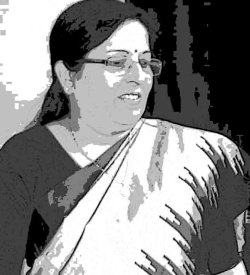Commentaries
Precisely one of the problems with many ICT4D funding programmes is their insistence on seeking development solutions that take technology as their starting point.
 Precisely one of the problems with many ICT4D funding programmes is their insistence on seeking development solutions that take technology as their starting point.
Precisely one of the problems with many ICT4D funding programmes is their insistence on seeking development solutions that take technology as their starting point.
The Isis study on People’s Communication for Development is a highly valuable contribution to the critique of one of the dominant trends in development policies and information society discourse: that is, the assumption that “access to new ICTs will accelerate development through women’s integration into the global market economy.”
Indeed, despite repeated and often predictable failures, it is remarkable that many governmental and multilateral-supported development programmes continue to pump considerable funds into connectivity- related programmes in dispossessed communities, yet fail to provide parallel support for training, social and economic sustainability and community involvement.
This study provides structured arguments and concrete evidence that question such limited approaches as well as opening new perspectives for an alternative approach to the issue through the proposal of the “People’s Communications for Development Agenda”.
These brief comments-centred on the focus and conclusions of the study- stem from our experience of working with women’s and grassroots organisations in Latin America, including three recent subregional workshops on gender and communication, which in several aspects confirm the results of the Asian study.
In our exchanges and studies with national-level organisations that have grassroots constituencies in Latin America (particularly rural and indigenous groups), it has clearly emerged that the use of new ICTs and especially internet is enormously useful and empowering for external networking, and in some cases is beginning to be used for some internal, national-level inter-communications.
But at the grassroots level, as in Asia, face-to-face communications and traditional media are identified as the main and most useful means of communication.
Precisely one of the problems with many ICT4D funding programmes is their insistence on seeking development solutions that take technology as their starting point. Questions along the lines of “what development initiatives can we build using this technology?” tend to give rise to initiatives with a technological bias.
From our perspective, a key question would rather be: “what needs/ initiatives/ challenges in the areas of information/ communication/ culture/ knowledge does the community or organisation face, and how can they be addressed?”
It is in the process of defining communications strategies and policies in answer to these questions, that the most appropriate tools, media or mechanisms can be identified, according to the goals established. As the Isis study points out, in some cases these may involve new ICTs, but in many, not. Yet few ICT4D programmes are oriented at present to such an integral and flexible approach.
This does not mean, as the study points out, that new ICTs will always be irrelevant to grassroots organisations. Precisely the obstacles the study cites include the lack of adequate access, training, knowledge of the tools, content in local languages, etc.
As these obstacles are surpassed, judging by the experience in Latin America, we could expect that young people in particular will be the quickest and most eager to learn to use these tools and to find creative ways of putting them to use.
Integrating ICTs into cultural creation, intercommunity networking, community media, retrieving and systematising local knowledge, among other uses, could well open up new avenues for grassroots communication initiatives.
While the Isis study focuses mainly on communication tools, it also points out the shortcomings in terms of communications strategy of the organisations and intermediary groups participating in the study, and this largely applies in Latin America as well. In the search for solutions to this drawback, organisations would need to examine in greater depth their own communication processes. This might be a new vein of exploration to pursue in the future.
- Sally Burch, Executive Director, Agencia Latinoamericana de Información (ALAI)
 Community access is underpinned by the premise that information and communication ought to be a public good and that citizens have a right to information.In the last few years, the ICT for development paradigm have come under close scrutiny. The assessment has been along the same lines – How is ICT4D contributing to development?
Community access is underpinned by the premise that information and communication ought to be a public good and that citizens have a right to information.In the last few years, the ICT for development paradigm have come under close scrutiny. The assessment has been along the same lines – How is ICT4D contributing to development?
This soul searching exercise within the sector is being done at the right time – a little over ten years after the roll-out of hundreds of ICT projects by governments, development agencies and civil society organisations. However timing is only the beginning, what matters most are the kinds of questions that are being asked and who are answering these questions?
Isis International’s study of communication tools for grassroots women’s empowerment in five Asian countries asked the question ‘Has the emergence of ICTs affected the way in which intermediary groups use traditional communication tools in reaching grassroots women?’.
Ten years after the promise of ICTs empowering poor communities, 81 intermediary groups who work with women demonstrated how in their experiences ICTs have failed to live up to their development potential.
While the study mainly argues that policies and politics that have privileged new ICTs over traditional forms of communications need to be reformed, I find that the most compelling evidence that this study reveals is a strong argument to advocate for universal access to information and communication infrastructure in developing countries.
The evidence collected by the study showed that the new ICTs were least effective because of prohibitive costs and the lack of infrastructure. The study powerfully concludes that the key issue in gender and development and communication policy is access and advocates for community access to the mass media as well as to new ICTs for women’s empowerment.
Community access is underpinned by the premise that information and communication ought to be a public good and that citizens have a right to information. Access is about infrastructure policies as much as it is about policies of content and openness and about insisting on our communication rights. All these will take us full circle – back to what really matters for women on the ground.
We should be free to empower ourselves with every kind of communication tool and practice
– old and new, traditional or modern, virtual or direct interaction.
- Chat Garcia, Coordinator, Association for Progressive Communications Women’s Networking Support Programme (APC-WNSP)
 The idea that ICTs are ‘safer’, more controllable and less threatening to established interests is not unique to Cambodia. It may go some way towards explaining why national policy makers are willing to support or permit ICTs but not the more traditional communication tools.
The idea that ICTs are ‘safer’, more controllable and less threatening to established interests is not unique to Cambodia. It may go some way towards explaining why national policy makers are willing to support or permit ICTs but not the more traditional communication tools.
The danger with this very substantial study is that it might be judged by how well it knocks down a ‘straw man’ of its own making. Roughly, the argument it sets up is: In the current paradigm, it is widely assumed both that ICT is the best communication medium always and everywhere, and that access to ICT will inevitably lead to the empowerment of women.
The research proceeds to knock this assumption solidly on the head, demonstrating the limitations of ICT – even where access is possible - in terms of their comparatively low potential for effective use by, and empowerment of, grassroots women.
In fact, such an apparently naïve view of the potential of ICTs – the ‘straw man’ - is held by few: By some donors with national ICT industry connections, a few ICT ‘techies’, but also in my experience by some national policy makers.
What is behind this? Donor national self-interest is clear enough, and ICT techies may be trapped in their own paradigm, lacking development experience.
But why are these views promulgated by some policy makers in poor countries? In whose interests is it to largely ignore the more traditional means of communication such as radio, face-to-face interaction, theatre and so forth?
One explanation is forthcoming in a Cambodian project I work on. The project’s goal is to combine ICT services with community radio, in a community-owned enterprise designed to empower rural villagers, especially women. The ICT services (based in small networked telecentres) are moving ahead, and the main beneficiaries so far are students, young people and a few NGOs.
While the women are happy to see their children gain skills, the community radio that would potentially be empowering for them (and they are well aware of this) has been refused a license quite explicitly because of official worries that views critical of the government and the status quo would be voiced and broadcast - views that would off course be highly empowering (as well as downright risky).
The idea that ICTs are ‘safer’, more controllable and less threatening to established interests is not unique to Cambodia. It may go some way towards explaining why national policy makers are willing to support or permit ICTs but not the more traditional communication tools.
It also suggests a line of enquiry down which this publication takes the first few steps: In cases where more traditional methods of communication with grassroots women are not available, what can we do to make ICTs more accessible, relevant and empowering? Our Cambodian project has no choice but to find ways in which ICTs can be empowering for women.
In exposing clearly the obstacles to ICTs achieving this goal, this report is potentially very useful to us. And it also demonstrates, through examples, that where access to ICTs (both physically and culturally/linguistically) is achieved; where the skills demanded can feasibly be learned and deployed properly; then ICTs can indeed be empowering.
This work has no need to prove its value by demolishing flimsy ‘straw men’. It is full of useful insight and interesting analysis, and offers a coherent and systematic analysis of the use of communication tools to empower grassroots women.
In addition to being a thorough and timely reminder of the absolutely critical role of traditional communication tools and the need to support them, it also makes a case for the more effective and empowering use of ICTs.
- Sean O’ Siochru, Author, Communicating in the Information Society Coordinator, Communication Rights in the Information Society (CRIS) Campaign

 We’ve been impressed by the thoughtful, reflexive and formative research process that has characterised this project. In addition to a campaign that puts people, specifically grassroots women, at the centre of development communication, the project has forged a collaboration of Asian feminist scholars whose action research agenda seeks to transform gender relations and elevate the importance of everyday voices in the development agenda.
We’ve been impressed by the thoughtful, reflexive and formative research process that has characterised this project. In addition to a campaign that puts people, specifically grassroots women, at the centre of development communication, the project has forged a collaboration of Asian feminist scholars whose action research agenda seeks to transform gender relations and elevate the importance of everyday voices in the development agenda.
The People’s Communication for Development campaign is an outcome from a research project undertaken by the women of Isis and their partners in four other Asia countries, with the support of IDRC’s Pan Asia Networking Program. Specifically, the research questioned the values placed on various ICTs as these relate to grassroots women.
By situating new ICTs as part of a continuum of communication tools, they sought the perspectives of intermediary groups working with grassroots women’s organisations and the perspectives of grassroots women themselves on which tools were most effective.
Feminist researcher Geraldine Pratt1 describes the research process as a lively, halting and political encounter, and this has certainly been the case for the Isis Research Teams and their research partners at the Aalochana Centre for Documentation and Research on Women, India; Civil Media Development Institute, Thailand; FemLINK Pacific, Fiji; and HELP Resources, Papua New Guinea.
As the responsible officers at IDRC, we’ve been impressed by the thoughtful, reflexive and formative research process that has characterised this project. In addition to a campaign that puts people, specifically grassroots women, at the centre of development communication, the project has forged a collaboration of Asian feminist scholars whose action research agenda seeks to transform gender relations and elevate the importance of everyday voices in the development agenda.
As the PC4D research agenda evolves, we encourage Isis and their partners to continue enriching the feminist agenda on new and old ICTs by integrating the grassroots voices into the dialogue and debate and exploring the nuances that underlie the relationships within ICTs for Development.
In so doing we hope to enhance their analytical capacities even further so that rich feminist analysis of both the material and symbolic aspects of gender and ICTs will transform their design, function and use to be truly accessible for all.
- Kathleen Flynn-Dapaah, Senior Programme Officer and Chaitali Sinha, Programme Officer, International Development Research Centre (IDRC)
Footnote:
1 Pratt, Geraldine. 2000. “Research Performances” Environment and Planning D: Society and Space vol. 18, pp 639-651.
In an epoch of media boom, even though rapid exchange of information and knowledge sharing is possible, yet many communities still remain distant and removed from such global knowledge networks, is an important and poignant reality.
We are experiencing new media. But there are people who are not exposed to any mode of communication, even traditional. Their unheard voices, unshared knowledge, un-echoed concerns are awaiting recognition.
With the convergence of traditional and new media, the communications experts are trying to blend the two flavours and reaching to the communities to provide this blend of tools in their hands for its effective use in empowering the communities for effective and meaningful communications.
The research findings of People’s Communications for Development acknowledge radio as a powerful tool for communications, followed by film and theatre. Radio, being the traditional media tool, with the Community Radio Policy, liberalising the airwaves in India, the use of radio by communities, especially, women is still a major concern. There are interesting projects with women’s enthusiasm seen for using ICTs, but simultaneously, there is a need to understand the reality and the challenges being faced by them. Women have less online access than men, for all gender stereotypical reasons — time, money, control, learning opportunities, etc.
 There are interesting projects with women’s enthusiasm seen for using ICTs, but simultaneously, there is a need to understand the reality and the challenges being faced by them. Women have less online access than men, for all gender stereotypical reasons — time, money, control, learning opportunities, etc.
There are interesting projects with women’s enthusiasm seen for using ICTs, but simultaneously, there is a need to understand the reality and the challenges being faced by them. Women have less online access than men, for all gender stereotypical reasons — time, money, control, learning opportunities, etc.
There is a need to design the programmes in a manner that ICTs could be placed in the hands of communities to make them active users and not passive recipients. The communities should have understanding on the importance and role of community media; how community media and ICT tools could be interwoven; role and importance of local voices, content, knowledge and its sharing. In the process, they should develop community ownership and maintain sustainability for such initiatives, to let people guide these processes independently, without any external support.
- Geeta Malhotra, Rural Education and Development (READ) - India





 The
The 
 Isis Resource Center holds one of the largest feminist collections of materials in the Global South. With 40 years of publication experience, Isis holds a vast collection.
Isis Resource Center holds one of the largest feminist collections of materials in the Global South. With 40 years of publication experience, Isis holds a vast collection.